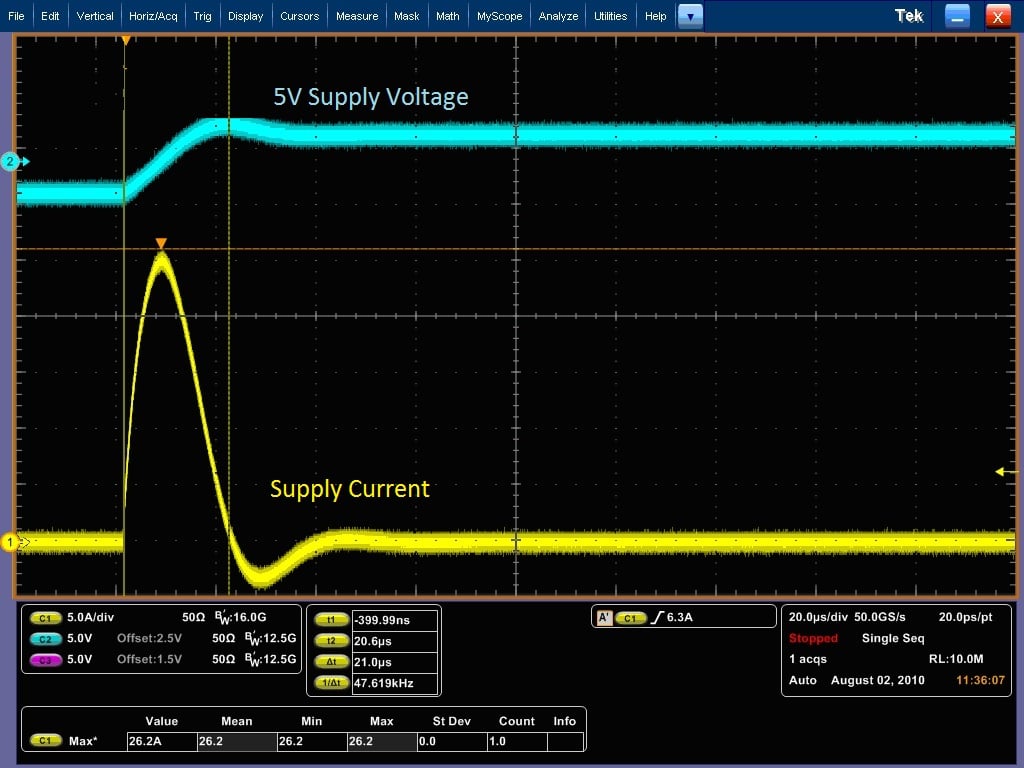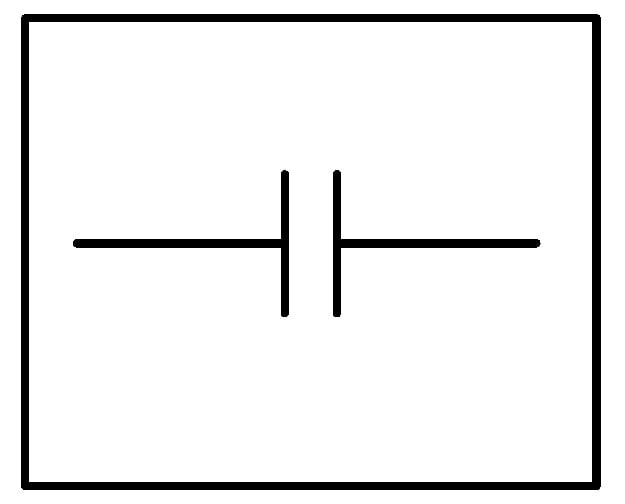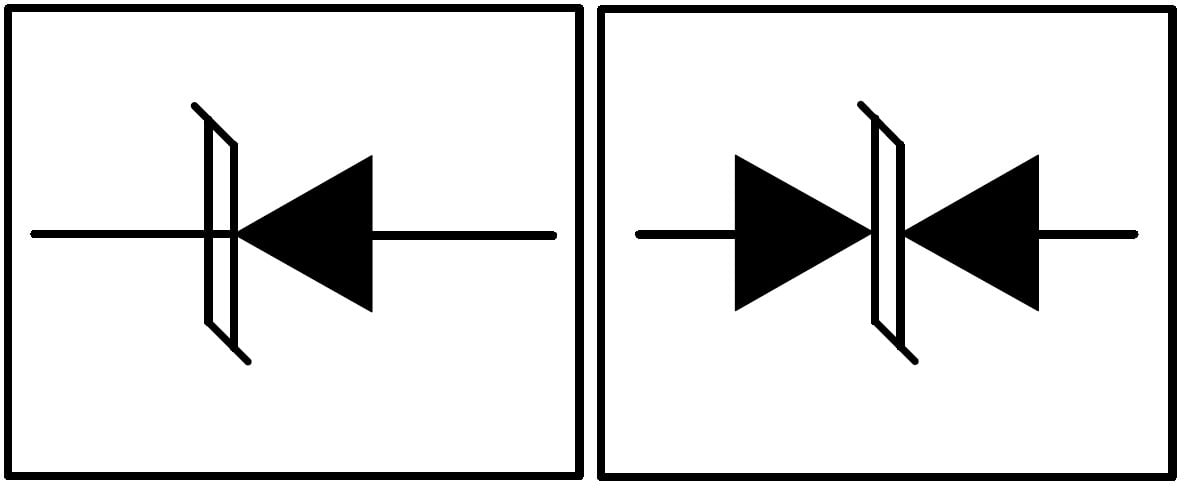This article is an intro to
transients and the devices used to suppress them. In it, you'll learn
about a variety of devices used to suppress transients, including
transient voltage suppressor diodes, metal oxide varistors,
PolySwitches, and avalanche diodes.
Current transients can be caused, for example, by inrush current. The figure below shows a device being hot-plugged.

Inrush Current Spike/Transient.
The applied voltage is 5V (cyan waveform) while the current—technically known as the "inrush current"— (yellow waveform) surges very high: its measured value is 26.2 Amps with a time duration of 21.6µs. In this instance, the device, itself, is able to withstand the current transient. However, depending on the current-sourcing capabilities of the connected power supply, it may become current-limited and, as a result, may starve the device of current. This can result in an undesired device reset or worse.
Origins of Transients
Transients can be generated from internal or external connections to a circuit. Examples of internally generated transients include:- Inductive load switching:
- relay coils
- motors
- solenoid coils
- transformers
- Arcing:
- faulty contacts in breakers, switches, and connectors
- motors with faulty windings or insulation
- poor electrical wiring
- poor grounding
- IC logic switching:
- TTL
- CMOS
- Power input lines:
- lightning strikes
- inductive switching caused by the turning on of other equipment connected to the same power source
- Data/signal input and/or output lines:
- I2C
- serial communication
- Ethernet
- Other attached wires/cables, such as grounds
Devices Used to Suppress Transients
There is a multitude of devices that can be used to help suppress voltage transients. Such a device is referred to as a Transient Voltage Suppressor (TVS). A few of the more popular TVS devices are listed below.Bypass Capacitor
Bypass capacitors—used for suppressing voltage transients—are also referred to as decoupling capacitors. Such capacitors, usually in sets of two or three with values of one or two orders of magnitude between them, are often placed at each power source as well as at each analog component to ensure that power supplies are as stable and noise-free as possible.
Capacitor symbol
Typical values:
- For logic applications: 0.01 - 0.22µF
- For power applications: 0.1µF and greater
- Low-power applications
- RC snubbers
- Decoupling of digital logic power rails (for cleaner power)
- Low cost
- Readily available
- Simple to apply
- Fast acting
- Uneven suppression
- Many may be required: one or two for each individual device
Zener Diodes
A Zener diode is a specially designed diode that has a reduced breakdown voltage called the Zener voltage. These diodes exhibit a controlled breakdown which allows the current to keep the voltage across the Zener diode close to the zener breakdown voltage. As a side note, this characteristic is what makes zener diodes useful for generating reference voltages.Zener diodes are also often used to protect circuits from overvoltage transients, such as ESD events.

Zener diode symbol
Applications:
- Diversion/clamping in low-energy circuits
- Good for high-frequency circuits
- Good for high-speed data lines
- Low cost
- Fast acting
- Easy to use
- Readily available
- Standard ratings
- Bidirectional
- Calibrated clamping voltage
- Usually fail open (as opposed to fail short)
- Limited to low-energy handling
Transient Voltage Suppressor Diodes
Transient voltage suppressor diodes are very popular devices used to instantaneously clamp transient voltages (e.g., ESD events) to safe levels before they can damage a circuit. Although standard diodes and Zener diodes can both be used for transient protection, they are actually designed for rectification and voltage regulation, and, therefore, are not as reliable or robust as transient voltage suppressor diodes.
Transient Voltage Suppressor (TVS) Diode Symbols: Unidirectional (left) and bidirectional (right).
Applications:
- Diversion/clamping in low-energy circuits and systems
- Good for moderate-frequency applications
- Fast acting
- Easy to use
- Readily available
- Bidirectional or unidirectional
- Calibrated low clamping voltage
- Fails short-circuited
- High capacitance limits frequency
- Low energy handling
- More expensive than Zener diodes, or MOVs
MOVs (Metal Oxide Varistors)
A metal oxide varistor (MOV) is a bidirectional semiconductor voltage transient suppressor. MOVs behave as voltage-sensitive variable resistors. The voltage at which the device conducts (i.e., switches) is a function of the number of grains between its electrode leads. This value can be varied, during the manufacturing process, to create any desired voltage breakdown threshold.
MOVs (Metal Oxide Varistors) symbol
Applications:
- Diversion/clamping in most low- to moderate-frequency circuits at all voltage and current levels.
- Can be used in AC or DC applications.
- Low cost
- Fast acting
- Readily available
- Calibrated low clamping voltage
- Easy to use
- Standard ratings
- Bidirectional
- Fails short-circuited
- Moderate- to high-capacitance limits high-frequency performance.
- Can only dissipate a relatively small amount of power, and, therefore, are unsuited for applications that demand continuous power dissipation.
Avalanche Diode
Avalanche diodes, like Zener diodes, are designed to break down and conduct very high currents at a specific reverse-bias voltage. This behavior is referred to as the avalanche effect. Similar to Zener diodes, which are somewhat restricted in the maximum breakdown voltage range, avalanche diodes are available with breakdown voltages over 4000 V.Avalanche diodes are connected in a reverse-biased configuration, i.e., the cathode is connected to the more positive voltage. Thus, during normal conditions the diode has minimal effect on the circuit, but when the voltage across its terminals exceeds the specified threshold, it begins to conduct.

Avalanche diode symbol
Applications:
- Used to protect circuits against damaging high-voltage transients.
- Specified with a clamping voltage VBR (breakdown voltage).
- Specified with a maximum-sized transient that it can handle.
- The avalanche breakdown event is not destructive—assuming the diode isn't overheated.
- A known side effect is RF noise generation.
PolySwitch
A PolySwitch (also referred to as polyfuse or resettable fuse) is a positive temperature coefficient (PTC) resistor that is constructed from a conductive polymer mixture. During normal operating conditions (i.e., during normal temperature conditions), the conductive elements within the PolySwitch form low-resistance "chains" which allow for the current to flow rather easily. However, when the current flowing through these chains increases to a point where their temperature rises above some critical threshold (a point called the "trip current"), the crystalline structure of the conductive polymer abruptly changes into a stretched out and shapeless state which, as a result, increases the resistance of the PolySwitch, which causes a sudden drop in current flow. Once tripped, the PolySwitch will remain in the tripped state until the the fault is removed and the temperature of the PolySwitch returns to a safe level.
PolySwitch symbol
Applications:
- Overcurrent protection for speakers, motors, power supplies, and battery packs
- Where a self-resetting fuse (i.e., a fuse that does not require replacement) is needed
- Low cost
- Easy to use
- Self-resetting
- Requires a cooling-down period to reset







No comments:
Post a Comment